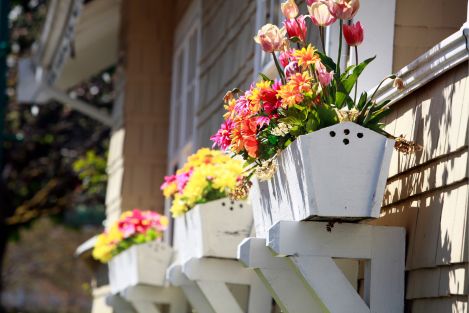
Written by Kayla Jane Barrie Updated on Mar 10, 2025 6 mins read

After a long winter, we’re sure you are looking forward to spending some time outside and enjoying the warm weather, even if it means checking items off your spring home maintenance checklist. Follow this spring maintenance checklist for your home to ensure your property is ready inside and out for the season - and don't forget to review your home insurance to ensure you have proper coverage at the best price.

After a long winter, we’re sure you are looking forward to spending some time outside and enjoying the warm weather, even if it means checking items off your spring home maintenance checklist.
The key to making sure you don’t miss anything is to create a checklist. Great news – we’ve already put one together for you.
Follow this spring maintenance checklist for your home to ensure your property is ready inside and out for the season - and don't forget to review your home insurance to ensure you have proper coverage at the best price.
Homeowners want low maintenance. To achieve this, you need to be diligent and complete your to-do list each season to keep your home in the best shape possible.
Here is why seasonal maintenance is essential:
Even when spring arrives, it can sometimes be too cold to do maintenance outside. The good news is that you can start inside. Here is a checklist of interior maintenance tasks:
A change of season is the perfect time to check your smoke and carbon monoxide detectors, make sure they are working correctly and change the batteries. Check your fire extinguishers to ensure no leaks and the pin is in place. Contact your insurer to clarify how much protection you have, or if you need additional fire insurance.
Spring cleaning is a common thing that many homeowners do as spring approaches. The warmer weather gives us a boost of energy to clean out the clutter and get our space in order before the nice weather hits.
It’s a good time to deep clean spaces that are often neglected, such as:
Focusing on the deep clean will help remove dust, mites, and other allergens from your living space.
Spring is the perfect time to ensure your air conditioner or HVAC system is working efficiently and ready for the summer. Check all the connections, change the filter, and, if necessary, have it serviced.
Electrical systems are often overlooked for home maintenance (until you don’t have any power). Prevent future issues by testing the ground fault circuit interrupters and the electrical panel. If you are ever unsure, contact a professional.

It’s essential to check the attic to ensure no leaks have developed from melting snow. You will also want to ensure that no mice, insects, or other critters have nested over the winter. Check the insulation to ensure it is intact. Look for signs of damage from mould and water.
We all know that the basement is prone to issues, especially after the seasons change. Check for cracks in the cement walls and look for signs of leaks.
While you are down there, it’s also a good idea to check your sump pump, washing machine hoses, inspect the basement windows for mould and leaks, and signs of pests. Basements are also at risk for backwater floods - you may want to get sewer backup insurance.
Building on the previous point, looking for leaks and mould is important in all areas of your home. Take the time to inspect all windows, doors, bathrooms, and other places where damage from water could occur. Address these issues immediately. If you have a large amount of it, contact a remediation company to dispose of it properly. Additional water damage insurance can protect you if there are any accidents.
Things can add up quickly, especially after the holiday season. Spring is the perfect opportunity to clean out the garage, basement and other areas where things have been piling up. Donate unwanted items to local charities, sell them online, or give them away to family and friends. You may want to consider contents insurance for valuables you want to keep.
With another winter in the rearview, it’s time to inspect your home and see if it caused any damage. The signs of winter damage often reveal themselves once the weather warms up and the ground thaws.
Here is a checklist of things to inspect:
It is vital to ensure your roof is free of damage. An issue with your roof, such as damage to shingles, flashing, or leaks, can quickly impact other areas. Look for missing, torn, or curling shingles and any shingles with missing granules. Some of these repairs won't be included in roof insurance.
Over time, gutters and downspouts can get clogged, especially if you have many trees and vegetation in your neighbourhood. We all know that clogged gutters can cause water damage and prevent water from being directed away.
Remove any debris, patch holes in your gutter with exterior grade caulking, and check your downspouts to ensure they are properly directing it away from your structure.
Your foundation is often the source of water issues in your basement. Do a walk around the exterior, check for cracks in the foundation, and inspect the exterior walls, siding, and brick for damage. If you identify issues, contact a foundation specialist to look.
The cold weather can cause cracks or harden the caulk around your windows and doors. Inspect the seals on all windows and doors and replace them as required. This will help prevent water from getting in and help reduce your energy bill. Replace any broken or damaged screens.
Check the garage doors to make sure they are working. Vacuum dust and dirt around the doors, make sure nothing could fall and prevent the doors from working properly.
If you have a fireplace or wood burning stove, it’s important to check the chimney and the unit for any blocks or damages. Look between the joints of bricks and stones.
Now that it's warm enough (and the rain has finally stopped), it's time to get outside and warm up your green thumb. Here are some yard maintenance tips this spring:
It’s time to get the lawnmower out, change the engine oil, and sharpen the blade, so it’s ready for the season. Head to your local hardware store to stock up on landscaping supplies such as yard bags and grass seed, and pick up the tools you need to thatch, weed and clean out your garden beds.
You’ll want to do a walkthrough around the property. Look for any branches that are getting close to your building or if they are at risk of falling.
Checking your fence and deck is important. Look for signs of damage, cracked or split boards, unstable areas and signs of pest damage. Look for holes under the deck and fence. Depending on the type of wood, you may also need to seal or stain your deck.
Pull out your patio furniture from storage, clean out your BBQ and get it ready for grilling season. Check your propane tank and get it filled if necessary.

It’s common to find cracks in walkways and driveways after the winter. How you repair these cracks will depend on the type of surface you have (brick, asphalt, concrete).
Check exterior lights and motion sensors to ensure they function properly and replace bulbs as necessary. You can also take this time to re-install solar lights in your walkways and gardens.
Here are some additional tasks you may also want to complete this season:
While you’re ensuring the safety of your home, don't forget to review your policy and contact us to find a more affordable car insurance quote.
| Categories | Home |
|---|---|
| Tags | Seasonal HomeHome Maintenance |
Read our insurance blog to get helpful tips, information and news.
Has your car been totalled in an accident? Is your car a write off? Learn about vehicle write offs for a total loss insurance claim.
Get the facts on Toronto's auto theft problem. We break down the data, reveal the most-stolen vehicles (including the Honda CR-V and Lexus RX 350), and show which neighbourhoods are most affected.
Dive into the world of auto theft with our blog on the most stolen cars in Canada. See the most stolen cars across Canada, including provincial lists for Ontario and Quebec, and learn how high-risk models can affect your car insurance premiums.
Drive safe this winter! Check out these tips for driving in snowy and icy conditions in Ontario. Get other helpful info and FAQs on winter driving.